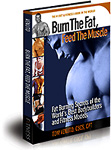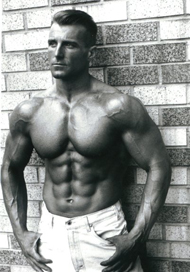By:Tom Venuto
URL:www.BurnTheFat.com!
Word count: 1238 words
QUESTION: “Tom, I know what I want to look like and I follow your
advice about visualization and seeing my abs the way I want them to look. But
what I can’t figure out is what body fat % I should be aiming at to achieve that look? I am female, 35 yrs old and I’ve done awesome on your Burn the Fat, Feed the Muscle program. I started at 19% body fat and the lowest I’ve gotten so far was 11.8% body fat with a caliper test. I’ve been thinking about doing a figure competition, but even at that body fat percentage, which I know is very low, I still had some “patches” of fat. How do I know what body fat percentage I should target so that all the fat is gone?”
ANSWER: Congrats! For most women, 11.8% is ripped, and for many women,
that’s contest ready.
Just for comparison, I’ve done over 7,000 body fat tests during my career,and the lowest I have ever measured on a female was 8.9% (4-site skinfold method).
She was a national-level figure competitor and she was shredded – full six pack of abs… “onion skin!” However, I do know some women who get down to 11-13% body fat – by all
standards extremely lean, complete with six pack abs – but oddly, they still had a few stubborn fat spots – usually the hips and lower body – so this would confirm your experience.
I know a guy who looks absolutely chiseled in his abs at 11% body fat, but other guys don’t look really cut in the abs until they get down to 6-8% body fat.
That’s the trouble with trying to pin down one specific body fat number as THE body fat level for seeing 6-pack abs (or being contest or photo-shoot ready).
Everyone distributes their body fat differently and two people may look different at the same percentage.
Here’s what I’d recommend:
Get familiar with some benchmarks for body fat levels.
My www.BurnTheFat.com!
has a body fat rating scale, which includes averages and my suggested optimal body fat percentages.
This is my own chart, which I created with a combination of research
literature and my own personal experience.
:: Burn The Fat, Feed the Muscle Body Fat Rating Scale ::
WOMEN:
Competition Shape (“ripped”): 8-12%
Very Lean (excellent): < 15%
Lean (good): 16-20%
Satisfactory (fair): 21-25%
Improvement needed (poor): 26-30%
Major improvement needed (very poor):
31-40+%
MEN:
Competition Shape (“ripped”): 3-6%
Very Lean (excellent):< 9%
Lean (good): 10-14%
Satisfactory (fair): 15-19%
Improvement
needed (poor): 20-25%
Major improvement needed (very poor): 26-30+%
Just a quick note: You’re not destined to get fatter as you get older, but in the general population (non fitness and bodybuilding folks), the average older person has more body fat.
What I did to accomodate this is to include a range instead of one number, so younger people can use the low end of the range and older people can use the higher number.
Also, just so the average reader can keep things in perspective, single digit body fat for women and low single digits for men is far beyond lean – it’s
RIPPED – and that’s usually solely the domain of competitive physique athletes. Competition body fat levels were not meant to be maintained all year round.
It’s not realistic and it may may not be healthy, particularly for women.
The average guy or gal should probably aim for the “lean” category as a realistic year round goal, or if you’re really ambitious and dedicated, the “very lean category.”
You’ll probably have to hit the “very lean” category for six pack abs.However, the bottom line is that there’s no “perfect” body fat percentage where you’re assured of seeing your abs.
Besides, body fat is one of those numbers that gets fudged and exaggerated all the time. I hear reports of women with body fat between 4 and 8% and I usually dismiss it as error in measurement (or there’s some “assistance” involved). Body fat testing, especially with skinfolds, is not an exact science.
All body fat tests are estimations and there is always room for human error.
The low numbers are nice for bragging rights, but the judges don’t measure your body fat on stage. What counts is how you look and whether you’re happy with that (or whether the judges are happy with it, if you’re competing).You can use my chart to help you set some initial goals, but for the most part, I recommend using body fat testing as a way of charting your progress over time to see if you’re improving rather than pursuing some holy grail number.
One final note: there are always a few people out there who take exception to my body fat rating scale. More often it’s females than males. More often older than younger. And more often non athletes than athletes. Usually it’s because they have a body fat of 26% or 27% or thereabouts, they are perfectly healthy and they are not significantly overweight. They argue that a body fat of 26% or so should not be rated as “poor” and that the standards on my chart are too high.
Having been influenced by the bodybuilding and physique world my entire life,I do have high standards, and my chart is admittedly skewed slightly toward an athletic population. However, for a young girl, 26% body fat and for a 40 or 50-something woman, 30% body fat, does in fact, leave plenty of room for improvement which is exactly what the chart says.
I’d like to encourage all my readers to consider setting higher standards and loftier goals. Not everyone wants or needs to be “ripped.” But in my opinion,many people set goals too low and settle for what they think they can get, not what they really want. With that said, please use my chart only as a guideline and not as gospel. Ultimately, it’s up to you to set your own goals and standards. if 6-pack abs are your goal, I think this info should give you a better idea of what it will take.
In my Burn The fat, Feed The Muscle system, you can learn more about how to measure your body fat – professionally or even by yourself in the privacy of your own home.
Burn The Fat, Feed The Muscle explains why body mass index and height and weight charts are virtually worthless, and shows you how to track your body composition over time and “tweak” your nutrition and training according to your weekly results.
Get more details at: www.BurnTheFat.com!
Train hard and expect success!
Tom Venuto, author of
Burn The Fat Feed The Muscle www.BurnTheFat.com!
www.BurnTheFat.com!
About the Author:
Tom Venuto is the author of the #1 best seller, Burn the
Fat, Feed the Muscle: Fat Burning Secrets of the World’s Best Bodybuilders and
Fitness Models. Tom is a lifetime natural bodybuilder and fat loss expert
who achieved an astonishing 3.7% body fat level without drugs or supplements.
Discover how to increase your metabolism and burn stubborn body fat, find out
which foods burn fat and which foods turn to fat, plus get a free fat loss
report and mini course by visiting Tom’s site at: www.BurnTheFat.com!







